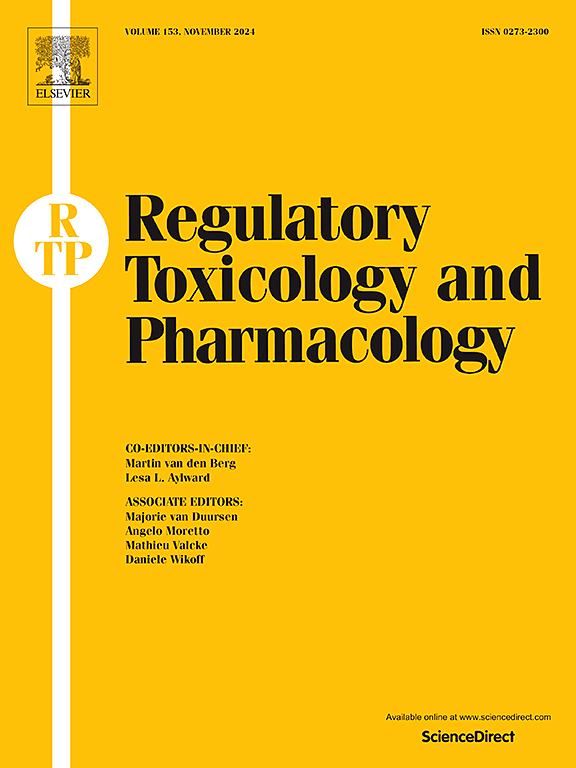MGK-264对大鼠甲状腺滤泡细胞肿瘤形成的作用模式分析及其与人的相关性
IF 3
4区 医学
Q1 MEDICINE, LEGAL
引用次数: 0
摘要
一种杀虫增效剂MGK-264 (N-(2-乙基己基)-5-降苯烯-2.3-二碳酰亚胺或N-辛基双环庚烯二碳酰亚胺)在雄性Sprague-Dawley (SD)大鼠中产生甲状腺滤泡细胞(TFC)肿瘤的致癌性研究。本研究的目的是评估MGK-264诱导TFC肿瘤的可能作用模式(MoA)及其与人类的相关性。在短期体内研究中,MGK-264治疗雄性SD大鼠导致肝脏UDPglucuronosyltransferase (UGT)对作为底物的甲状腺素(T4)的活性(UGT活性),血清T4水平降低,血清促甲状腺激素水平升高,MGK-264剂量水平下TFC肥大,TFC肿瘤在致癌性研究中被发现。排除了其他可能的moa,如遗传毒性、甲状腺过氧化物酶抑制和钠/碘同体抑制。因此,我们有理由推断,MGK-264通过诱导肝脏UGT活性,然后扰动下丘脑-垂体-甲状腺轴,对tfc具有有丝分裂活性,类似于苯巴比妥等其他肝脏外生酶诱导剂。文献资料表明,肝脏外源性酶诱导剂对甲状腺激素和甲状腺的影响在大鼠和人之间存在明显的物种差异。总的来说,提出的mgk -264诱导大鼠TFC肿瘤形成的MoA被认为在数量上不适合人类。本文章由计算机程序翻译,如有差异,请以英文原文为准。
Mode of action analysis for rat thyroid gland follicular cell tumor formation by MGK-264 and human relevance
MGK-264 (N-(2-ethylhexyl)-5-norborene-2.3-dicarboximide or N-octyl bicycloheptene dicarboximide), an insecticidal synergist, produced thyroid gland follicular cell (TFC) tumors in male Sprague-Dawley (SD) rats in a carcinogenicity study. The purpose of this study was to evaluate the possible mode of action (MoA) for TFC tumor induction by MGK-264 and its relevance to humans. In short-term in vivo studies, the treatment of male SD rats with MGK-264 resulted in induction of hepatic UDPglucuronosyltransferase (UGT) activity towards thyroxine (T4) as substrate (UGT activity), a decrease in serum T4 levels, an increase in serum thyroid stimulating hormone levels, and TFC hypertrophy at MGK-264 dose levels where TFC tumors were noted in the carcinogenicity study. Other possible MoAs such as genotoxicity, thyroperoxidase inhibition, and sodium/iodide symporter inhibition were excluded. Therefore, it is reasonable to conclude that MGK-264 has mitogenic activity on TFCs via induction of hepatic UGT activity followed by perturbation of the hypothalamus-pituitary-thyroid axis, similar to other hepatic xenobiotic enzyme inducers like phenobarbital. Literature data demonstrates that there are marked species differences between rats and humans in the effects of hepatic xenobiotic enzyme inducers on thyroid hormones and the thyroid gland. Overall, the proposed MoA for MGK-264-induced rat TFC tumor formation is considered quantitatively not plausible for humans.
求助全文
通过发布文献求助,成功后即可免费获取论文全文。
去求助
来源期刊
CiteScore
6.70
自引率
8.80%
发文量
147
审稿时长
58 days
期刊介绍:
Regulatory Toxicology and Pharmacology publishes peer reviewed articles that involve the generation, evaluation, and interpretation of experimental animal and human data that are of direct importance and relevance for regulatory authorities with respect to toxicological and pharmacological regulations in society. All peer-reviewed articles that are published should be devoted to improve the protection of human health and environment. Reviews and discussions are welcomed that address legal and/or regulatory decisions with respect to risk assessment and management of toxicological and pharmacological compounds on a scientific basis. It addresses an international readership of scientists, risk assessors and managers, and other professionals active in the field of human and environmental health.
Types of peer-reviewed articles published:
-Original research articles of relevance for regulatory aspects covering aspects including, but not limited to:
1.Factors influencing human sensitivity
2.Exposure science related to risk assessment
3.Alternative toxicological test methods
4.Frameworks for evaluation and integration of data in regulatory evaluations
5.Harmonization across regulatory agencies
6.Read-across methods and evaluations
-Contemporary Reviews on policy related Research issues
-Letters to the Editor
-Guest Editorials (by Invitation)

 求助内容:
求助内容: 应助结果提醒方式:
应助结果提醒方式:


